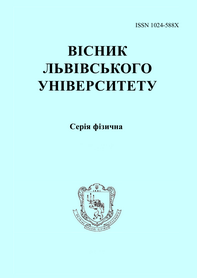DOI: https://doi.org/10.30970/vph.56.2019.133
Electronic energy structure of LaF3:Ce crystal
V. Karnaushenko, Ya. Chornodolskyy, S. Syrotyuk, A. Voloshinovskii

| Visnyk of the Lviv University. Series Physics
56 (2019) ñ. 133-139
DOI: https://doi.org/10.30970/vph.56.2019.133 Electronic energy structure of LaF3:Ce crystalV. Karnaushenko, Ya. Chornodolskyy, S. Syrotyuk, A. Voloshinovskii |  |
(íå ìåíøå 1800 çíàê³â) LaF\textsubscript{3}:Ce\textsuperscript{3+} crystals are high performance scintillators with a short decay time and high temperature stability of luminescence parameters. Understanding of the luminescence processes in LaF\textsubscript{3}:Ce\textsuperscript{3+} is required to predict new perspective scintillators, what makes knowledge about the positions of 4f and 5d Ce levels, relative to the valence band and the conduction bands, very important. Positions of these levels in relation to the conduction band define temperature stability of the luminescence. In this work theoretical studying of the total and partial densities of states and band energy structure of the LaF\textsubscript{3}: Ce\textsuperscript{3+} crystal (10\%) have been produced to obtain a detailed understanding of the peculiarities of the impurity levels positions and their nature. All calculations are made within the density functional theory framework using the projected augmented waves method and hybrid exchange-correlation functional PBE0. Aforementioned computations have been done using an open-source Abinit software and atomic PAW dataset, generated with atompaw. Positions and intensities of the 4f and 5d Ce states, in relation to the conduction band, have been analyzed. In this work also has been shown, that a major contribution in the valence band is made by 2p fluoride states. The bottom of the conduction band is formed by 5d levels of cerium, and 5d levels of lanthanum is placed just above it. Narrow 4f cerium electron states are characterized by a high probability of occupation by electrons and are situated in the middle of forbidden band at the level of 5 eV from the top of valence band. Strong electrons correlations have been taken into account using hybrid exchange-correlation functional, which has been adjusted by a mixing coefficient \alpha. Taking on \alpha=0 allows to ignore correlations between 5d and 4f electrons. Calculated band gap energy E\textsubscript{g}=8,1 eV for the LaF\textsubscript{3}:Ce (10\%) crystal is in good agreement with experimental data and has been achieved using \alpha = 0,95.